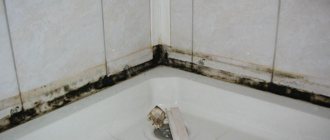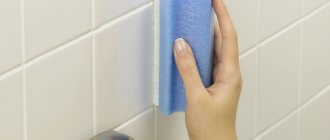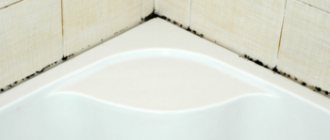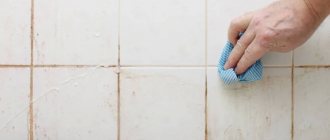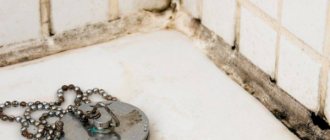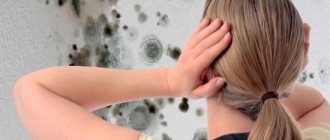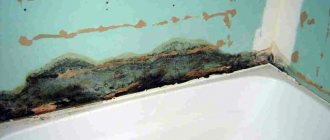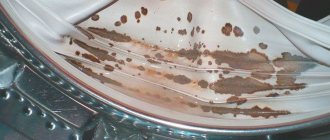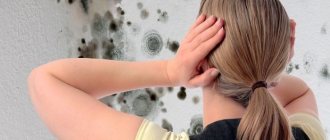The fact that black and gray plaque on the walls and ceiling in the bathroom is unaesthetic is not the biggest problem. It causes the greatest harm to health. The consequences of toxic spores getting into the lungs or bronchi can be the most unpredictable. Treatment after this will require long and serious treatment.
Therefore, if black mold is found in the bathroom, how to get rid of it must be decided immediately. Otherwise, it will quickly penetrate deep under the tiles, and it will not be easy to remove it from there. Our article is dedicated to ways to combat fungus - in this material we examined in detail the best store-bought and folk remedies for removing mold at home.
They also provided useful recommendations on the use of antiseptics and described preventive measures that can prevent the formation of fungus in the bathroom.
Causes of mold on the seams of tiles in the bathroom
The main difference between the bathroom and the rest of the apartment is the increased level of humidity. Regular washing, bathing, drying towels - all this makes the bathroom atmosphere suitable for the appearance and proliferation of mold. The list of the most common reasons for fungal spores appearing in the bathroom includes:
- incorrectly configured ventilation system or heating system - mold multiplies especially actively in warm, humid air;
- poor-quality sealing of interpanel seams and waterproofing of surfaces;
- problems with plumbing and pipes;
- formation of condensation on cast iron pipes;
- insufficiently thorough cleaning after using the room for its intended purpose—uncleaned drops of water provoke the development of mold;
- increased air humidity due to drying clothes.
The grout in the tile joints is also easy to become infected with mold, especially in the part of the finish that is adjacent to the bathroom - there is the highest humidity and temperature. Even treatment with a special antifungal liquid does not provide a 100% guarantee of protection against mold.
At the first signs of mold, it is necessary to take urgent measures to eliminate it, as well as to eliminate the source of this infection. Black mold is a very dangerous pathogenic microflora that negatively affects the health and sometimes even the lives of people living in the house.
Black mold is a health and life-threatening problem.
Prevention measures
Fighting fungus in the bathroom is much more difficult than preventing it. To keep your bathroom mold-free, follow these tips:
- Monitor the humidity in the room.
Inspect the condition of the pipes and plumbing to ensure there are no leaks. Pipes on which condensation appears must be insulated using an insulating tube or other material designed for this purpose. The air can be made drier by hanging a large heated towel rail in the bathroom or installing heated floors. - Provide good ventilation. Check how the hood works.
- Make sure that no cracks appear on the walls and ceiling.
Pre-cleaning of seams
Mold grows quite quickly, and begins to negatively affect the health of people living in the apartment immediately after it appears, so steps to remove it must be taken as soon as possible, at the first signs of black spots and dots. In addition to the mold itself, it is necessary to find and eliminate the cause of its appearance as quickly as possible, otherwise the mold will come back.
Before starting to treat the seams with mold-killing preparations, it is necessary to mechanically clean the tile seams, removing all visible stains and stains. For this you will need:
- gloves;
- respirator;
- hard brush.
Armed with these improvised means, they thoroughly clean all seams to remove traces of mold. Once cleaning is complete, it is best to throw away all these materials, as fungal spores may have become exposed to them during the cleaning process.
The first step is to clean the tile joints from visible traces of mold.
You can quickly and efficiently prepare seams for cleaning from mold using a steam generator. The principle of operation of the device is to supply water steam at a very high temperature under strong pressure - such a jet easily “knocks out” accumulated dirt, visible mold spores, and lime deposits from surfaces. After this treatment, the seams are ready for deeper cleaning and the use of antifungal drugs. All you have to do is wipe the seams thoroughly and dry so that no droplets of water remain in them.
The steam generator supplies hot water steam under pressure, which allows for high-quality cleaning of tile joints
Self-cleaning process
It is easiest to remove mold in the bathroom at an early stage of infection, when the number of colonies is small and the fungus has not yet penetrated deeply. In this case, use simple products such as baking soda and vinegar or professional mixtures.
You can use a toothbrush for cleaning, which is especially convenient for removing dirt in the joints between tiles. After cleaning, it is necessary to wash the treated surface with any detergent and wipe dry. To prevent the resumption of growth and spread of fungal colonies, it is important to eliminate the causes that provoke these processes already at this stage.
If the mold has spread and penetrated into the deeper layers, more radical methods will have to be used. At this stage, solutions of chlorine-containing agents, concentrated acetic acid, and a 3% solution of caustic soda are used to clean the tiles. When using these products to prevent burns and vapor poisoning, gloves and a respirator should not be neglected. Moisten the brush in the solution of the selected product and carefully apply it to the stain, leave for 15-30 minutes and rinse with clean water. If necessary, the procedure can be repeated.
If simple and affordable means fail, then professional industrial chemicals will help us solve the problem. They are used strictly according to the instructions and using personal protective equipment.
Which method is better to choose?
The choice of method for removing dirt in the bathroom depends on the area and depth of the lesion. To remove already formed fungal colonies and prevent their reappearance, it is best to use special products. They are not only more effective than the usual bleach or copper sulfate, but also much safer for the consumer and the environment.
If the remedies available for self-use are ineffective, you should seek help from specialists.
If all surface methods for removing contamination do not work, and the mold continues to grow, then you will have to remove the grout between the tiles, plaster and other finishing materials with fungal spores. After this, antifungal treatment with special agents will be required on all accessible surfaces.
Mold Removers
You can remove mold from the grout between tiles using different means. There are both special industrial antiseptic liquids and a variety of folk recipes. The first option looks more attractive due to reliability, the second - due to environmental friendliness and lower financial costs.
Effective folk remedies
In order to solve the problem, well-known remedies are used, which are usually used for medicinal, culinary or some other purposes.
Baking soda
Baking soda is often used to remove various stains. It will come in handy in this case too. Soda is used like this:
- The powder is diluted with water to a thick paste.
- All seams are treated with gruel using an unnecessary toothbrush.
- In this form, the bathroom is left for about an hour for a deep impact on the grout.
- The product is thoroughly washed off with water.
Baking soda is a product that is easy to find in a regular kitchen.
Table vinegar
Regular table vinegar can kill up to 80% of mold species, as well as eliminate the unpleasant odor that usually accompanies fungus. It can be applied to seams in two ways:
- moisten a cloth generously with vinegar and wipe the gaps between the tiles with it;
- pour vinegar into a spray bottle and spray the tile joints.
The liquid should be left on the wall until it dries completely, then treat the seams with a stiff brush and rinse them thoroughly with water.
Table vinegar kills not only mold, but also various germs and bacteria
Hydrogen peroxide
Hydrogen peroxide has antiseptic properties. It is easy to purchase at any pharmacy and is inexpensive. To remove mold you need to use it as follows:
- Apply the liquid to the grout between the tiles.
- Wait for it to dry naturally.
- Treat the seams with a stiff brush, removing traces of mold.
- Rinse the tiles with water.
Hydrogen peroxide has a slight whitening effect, so in the case of colored, and especially dark, tiles, it should be used with caution.
Hydrogen peroxide is easy to purchase at any pharmacy.
Boric acid
Boric acid is another pharmaceutical drug that is actively used as an antiseptic. It is used to remove mold not in its pure form, but in the form of a mixture in this way:
- Mix boric acid, table vinegar, hydrogen peroxide and water in a ratio of 1:2:2:4.
- Heat the resulting mixture slightly.
- Treat tile seams.
- Leave the mixture on the grout for 30–40 minutes.
- Rinse thoroughly with water.
Boric acid is a universal antiseptic and disinfectant
Borax
Borax is the sodium salt of boric acid, which is why it has similar antiseptic properties. This is a universal remedy against fleas, ticks, rust, and is used in industry, construction, and cosmetics. Sold in two versions - in bottles and in the form of a dry powder. Powder used to kill mold:
- A glass of powder is diluted in 4–5 liters of water.
- The liquid is applied to the surface to be treated.
- After 5–10 minutes, rinse thoroughly with water.
The scope of borax is extremely wide - construction, industry, cosmetics, and much more.
Ammonia
Ammonia, or ammonia, is a highly effective remedy for removing mold. However, it is worth remembering that the smell of ammonia can cause headaches and nausea, so it must be used with caution. While processing the seams, the door to the bathroom must be closed, and after finishing the work, the room must be properly ventilated. The product is used in the following way:
- Mix two glasses of water, a teaspoon of ammonia and 10-15 drops of tea tree essential oil.
- Treat the seams between the tiles with the resulting solution.
- Leave the mixture on the seams for 30 minutes.
- Rinse thoroughly with water.
You should never mix ammonia and bleach because the chemical reaction produces a toxic gas.
Ammonia is known largely due to its pungent and unpleasant odor.
Tea tree essential oil
Tea tree essential oil can be used in the fight against mold on its own, without adding additional drugs. The disadvantage of this method is the rather high price of the oil itself. The advantage is that the method is effective, since the oil not only kills mold, but also prevents its reappearance. You need to do this:
- Dilute 10 ml of tea tree oil in 500 ml of water.
- Apply the resulting solution to the tile joints.
- Leave until dry.
- Ventilate the bathroom.
Tea tree essential oil is often used in cosmetology, but its benefits are not limited to this.
Copper sulfate
Copper sulfate, or copper sulfate, is used not only in construction and gardening. The properties of the product also allow it to be used to combat mold. It is important to remember that copper sulfate solution is toxic and hazardous to health, so you must work with it with extreme caution and use protective equipment. This is done this way:
- A solution is created from 1 part copper sulfate and 10 parts clean water.
- The solution is applied to the grout between the tiles using a brush.
- After 2–3 hours, the treated surfaces are thoroughly washed with water.
Copper sulfate is hazardous to health, so it must be used using protective equipment.
Video: remedies for fungus in the bathroom
Industrial antiseptics
To clean the tile joints in the bathroom from mold, you can use specialized household chemicals.
Chlorine-based bleaches cope with this task. They not only remove the fungus, but also disinfect the grout - in the future, in places treated with chlorine-containing mixtures, mold stains either do not appear at all (if additional mold prevention measures are taken) or appear much later. The disadvantage of such drugs is their high toxicity, which is why when working with them you need to use skin, respiratory and eye protection. Additionally, since their primary purpose is to whiten, they can affect the color of the grout and tiles.
One of the most famous bleaches is “Whiteness”. It effectively cleans surfaces of mold, but does not penetrate well into materials, so if there is extensive fungal infection, this method will not be effective - the mold will return again and again. In this case, you need to resort to more serious cleaning methods. Domestos is a more gentle version of household chemicals. It can be used not only to combat mold that has already appeared, but also as a preventive measure.
Whiteness is one of the most well-known chlorine-based bleaches.
Bleach should be used as follows:
- Dilute with water in a ratio of 1:10.
- Apply the resulting solution to the seams using a spray bottle or sponge.
- Wait 5–10 minutes.
- Use a stiff brush to thoroughly clean the seams.
- Rinse thoroughly with water.
In addition, there are special means for removing fungus and mold - chemical antiseptics that clean the surface and disinfect it. These are ready-made solutions that can immediately begin performing their task.
The most famous antiseptics:
- "Dali" is a Russian-made drug; universal remedy - capable of destroying not only fungi and mold of all types, but also mosses, algae, etc.; price - 150 rub. for a capacity of 0.6 liters;
- "Fongifluid Alpa" - fungicidal solution; sold in a ready-made diluted state; price - 550 rub. for 2 liters;
- "Olympus Stop Mold" - the product is intended for damp rooms, including bathrooms; does not contain chlorine compounds; price - 100 rub. for 1 liter;
- Mellerud is a Japanese remedy; perfectly removes moldy stains and fungal spores, penetrating into the very depths of the affected areas; price - 500 rub. for 500 ml;
- Prosept “Fungi clean” – removes deeply ingrained dirt from ceramic tiles and joints, has a disinfecting effect, blocks the development of mold and microorganisms, removes odors; price - 200 rub. for 500 ml.
Antiseptics are available in various form factors - liquid, spray, powder, felt-tip pen.
Photo gallery: industrial antiseptics
"Dali" is a universal antiseptic, safe for people and animals
"Fongifluid Alpa" can be used both for the treatment and prevention of mold.
"Olympus Stop Mold" is used for rooms with high humidity
Mellerud is a Japanese-made product with proven effectiveness
Prosept “Fungi clean” can be used both as a mold remover and as a detergent with a whitening effect
Household chemicals
Designed to quickly and effectively remove fungus, household chemicals can clean contaminated surfaces several times faster than any folk remedy.
If you are not allergic to the components of antifungal drugs and there are no pets in your apartment, then feel free to use special anti-mold chemicals.
"Belizna" - chlorine-based solution
The most famous and inexpensive product called “Whiteness” for 50 rubles. Excellent removes mold stains from various surfaces.
Spraying a bleach solution onto a whitewashed ceiling will remove mold stains and stop mold growth.
To prepare the solution:
- Bleach is diluted with water in a ratio of 1 to 10.
- Apply it to a cleaned surface and wait for it to dry.
The disadvantage of this product is the specific smell of chlorine.
Oxygen bleach
It is based on sodium percarbonate , which can cope with different types of mold.
This product is well suited for removing stains from colored surfaces. With its help, you can remove fungus from curtains in the bathroom, remove black stains from tile joints, curtains, etc.
There is a large selection of such bleaches on sale. The most famous:
- "Bos Plus" costs about 30 rubles;
- “Sano Oxygen”, it can be bought for 280-300 rubles;
- “Vanish Gold” for 140-150 rubles.
Special antifungal
Such products are distinguished by their speed of action and effectiveness . With its help you can easily tidy up:
tiles;- plumbing;
- shower cabin.
Cleaning surfaces will take from 10 minutes to an hour . The most popular products today are:
- “Cillit Bang”, price 150-170 rubles;
- spray “Unicum”, costing about 180 rubles;
- “Turbo”, priced at 300-350 rubles.
Professional method of combating mold using microwaves
The microwave method is based on the action of centimeter and millimeter frequencies, which lead to heating of the surface.
The letter combination microwave itself is probably familiar to almost everyone - this is what is sometimes called a microwave oven that operates precisely on this principle. Of course, it is not this device that will be used to combat mold, but a special microwave apparatus. With its help, those surfaces that need to be treated are heated, and they are completely dried, and all mold spores die from the high temperature. Without relying on subjective indicators, humidity and temperature during processing are measured with a moisture meter and pyrometer, respectively.
The advantages of this technique are as follows:
- rapidity;
- depth of influence;
- safety;
- the ability to penetrate hard-to-reach places;
- high efficiency.
There is only one downside - such a device is quite expensive and is not one of the frequently purchased devices. In order to use it, you need to contact specialists, and this costs money. However, this approach guarantees high-quality work and complete treatment of the room, after which mold will be completely defeated, because the craftsmen know all the intricacies of their craft.
A microwave device guarantees the destruction of mold by heating and drying surfaces
Using an Alternative Method
As an alternative to detergents and other anti-fungal drugs, exposure can be done using the microwave method. Many note that exposure to microwaves does not have a destructive effect on the finish; in addition, mold stains can be removed using this method.
Removing mold using microwave
The thing is that during treatment, microwaves act pointwise, namely only on the affected areas. This treatment is carried out using a special device that generates electromagnetic waves and creates vibration processes of water molecules in microorganisms. This process occurs most intensively in places with high humidity. It is worth noting that fungal microorganisms consist of almost 90% water and, as a result of this exposure, their heating occurs faster, unlike finishing materials. This all ensures rapid destruction of mold.
Further, this coating will protect against the appearance of mold stains and scratches. And the walls and appearance of the bathroom will always be beautiful. Using this method you can get rid of almost any fungus. But before treatment, you need to thoroughly check the room for fungal stains.
Actions in case of severe damage
Sometimes neither folk remedies, nor industrial antiseptics, nor professional devices help - the mold is nested too deeply and tightly and does not want to leave its habitat. Then the time comes for extreme measures - completely replacing the old grout with a new one. The procedure is as follows:
- Remove old grout.
- Clean the seams.
- Apply primer.
- Apply fresh grout.
Removing grout between tiles
First, it is necessary to completely remove the grout between the tiles to destroy the mold habitat, and apply new one. This can be done in various ways:
- mechanical - using a special tool (construction knife, dremel, joint spreader, electric drill), the grout is cleaned from the space between the tiles; this must be done carefully and carefully so as not to damage the tiles themselves and the enamel on them;
- chemical - special chemical reagents are used to soften the grout composition and facilitate its removal. They come in industrial grade - special solvents that do not damage the tiles: Keranet;
- Clean Kiilto;
- MasterGood; and folk ones - made from improvised means: a concentrated solution of vinegar or citric acid;
- a mixture of one part glycerin and three parts water;
- a mixture of water and kerosene or white spirit.
When removing old grout, you must not forget about protective equipment, since in the process you can get damaged by a tool or a flying piece of grout, and with the chemical method, you can get burned by reagents.
Cleaning seams and applying primer
After removing the grout, the tile joints must be thoroughly cleaned of old material. To do this, you can use an ordinary vacuum cleaner. After this, the seams must be washed with a solution of soap or a non-aggressive detergent and allowed to dry completely within 24 hours.
Next, a layer of penetrating primer is applied to ensure better adhesion of the grout to the surface and greater surface protection.
Applying fresh grout
The next step is to apply fresh grout. To protect it from mold, there are two ways:
- use a special anti-fungal grout - it already contains all the additives necessary to prevent the fungus from appearing and spreading. Such grouts can be found in the line of companies: Ceresit;
- Fuga De-Lux;
- Kerapoxy Design;
- Litokol and others;
- Ceresit CT-10;
To be more confident, you can combine these two methods - this option will be a little more expensive and labor-intensive than each of them separately, but will add reliability and protection against fungus.
Antifungal impregnation gives the grout water-repellent properties, protects against mold and dirt
At the stage of renovation of the bathroom, when we completely changed its appearance and, accordingly, re-tiled the walls, it was decided to use a special anti-fungal grout from the company Ceresit, and in addition to it, an anti-fungal impregnation for grout from the same company. It cost a little more than if we had bought simple grout, but it paid off in the future. Despite the lack of ventilation, frequent baths and our laziness, due to which we rarely wipe the tiles dry, 5 years after the renovation we still did not know what mold is.
Getting rid of mold and mildew
If mold has already appeared on the walls, then preventive measures will not help. Here you will need to use various mechanical, folk and chemical methods of control.
Types of mold
Getting rid of fungus mechanically
Many housewives, having discovered a black coating on the walls, try to remove it with a spatula. In order for this to be effective, certain nuances will need to be observed:
- The first step is to wet the stains with clean water - this will stop them from further spreading through the air.
- Then you will need to take any scraper with coarse sandpaper and carefully sand the surface. If necessary, you can remove the top layer from the ceiling using milling equipment.
Mechanically it will be possible to remove minor accumulations of fungus
In advanced situations, even such measures are not enough, so you will have to do a global repair, which involves the following:
- Removing the top covering from the wall, because mold can be under wallpaper or tiles.
- Cleaning the ceiling from the layer of lime and paint.
- Dismantling the floor covering.
When carrying out major repairs, the walls must be treated with a disinfectant. Moreover, such substances should be applied to all floors, even in places where mold does not spread.
Mold on the tiles in the bathroom
Note! For efficiency, the floors are treated at least three times in a row, following the drying steps. Only then is it permissible to apply finishing plaster.
Necessary safety measures when working to destroy fungus
Many mold removal products are toxic and poisonous, so when working with them you should follow safety precautions:
- wear gloves to protect your skin;
- wear a respirator to protect the respiratory system;
- Protect your eyes with goggles from getting dangerous liquids into them.
Protective equipment - goggles, waterproof gloves, a respirator - are required when working to remove mold.
If such liquids come into contact with the skin or eyes, the affected area should be rinsed with plenty of water and consult a doctor immediately. Even when using safe products, it is advisable to protect the respiratory system at the moment when active cleaning of tile joints with a brush is carried out, since mold spores can easily enter the body at this moment. It is also worth protecting the surfaces in the room so that mold spores do not enter and take root on them. To do this, everything that can be taken out of the bathroom should be taken out, and the rest should be covered with something dense - for example, polyethylene or a special film used in construction. Once cleaning is complete, this material should be discarded.
If the bathroom has forced ventilation in the form of a fan, it must be turned off during cleaning, since mold spores are easily picked up and carried by air movement.
All items used during cleaning - brushes, sponges, respirators, gloves - upon completion of work must be immediately placed in tight bags that exclude the possibility of ventilation and thrown away.
Danger of mold and mildew
Any fungi primarily destroy the ceiling, because they actively grow into the deep layers of the material. This not only provokes peeling of plaster and paint, but also cracks.
Having settled on the walls, colonies of protozoa absorb lime, which is why their number increases
If appropriate treatment is not carried out in time, the possibility of wall collapse cannot be ruled out. Of course, this only happens in exceptional cases, when there are too many colonies.
Another trouble is that fungi provoke the occurrence of various diseases. This category includes the following:
- fungal infection of the skin;
- headache;
- respiratory diseases;
- disorders of the gastrointestinal tract;
- diseases of the musculoskeletal system.
Note! If such a problem is left uncontrolled, the active spread of fungi will eventually lead to incurable disorders of the liver, respiratory tract and other vital organs of the household.
Pathogenic flora poses a great danger to people with weak immune systems, and in particular to elderly and seriously ill people and children.
Mold on walls causes severe allergies
Find out what to do if the windows in your apartment sweat from the inside, and also read about folk remedies in a special article on our portal.
Prevention of mold on tile joints
In order to prevent the occurrence of black mold in the seams between tiles, you should follow simple rules:
- you need to monitor the humidity level and not allow it to exceed it - for this you can install forced ventilation in the bathroom;
- in summer and winter, in addition to the heating radiator, there should be a heated towel rail in the bathroom; you can install a model that will operate from the network;
- do not forget about antiseptic drugs - they should be used at the repair stage, this increases the security and reliability of the grout;
- After each use of the bathroom, you need to carry out a thorough cleaning - wipe the tiles and tile joints dry so as not to provide mold with a breeding ground;
- Do not dry towels and linen in the bathroom.
The most vulnerable places for plaque to appear
First of all, mold settles in the seams between the tiles, as well as in places where plumbing fixtures are connected to the walls using sealant.
Washing off black deposits from such surfaces is a difficult and sometimes impossible task. Therefore, grout and sealant must be changed periodically .
The seams between the tiles are cleaned with a stiff metal brush, treated with an antiseptic and filled with grout with a special antifungal additive.
The sealant is removed from the joints with a special knife. The joint area is treated with a mold remover and the surface is allowed to dry. Then new sealant is applied to the prepared areas.
Read more about ways to remove mold on bathroom caulk here.
In the bathroom, mold may appear on the ceiling. If the affected area is small, you can treat the surface with bleach or another antifungal agent.
If bubbles of swollen plaster appear on the ceiling, then you will not be able to cope with the mold without repair work. You will have to remove the plaster .
To do this, moisten the ceiling with water using a brush for 2-3 hours. After this, the plaster can be easily removed.
Surface unevenness must be thoroughly puttied . After this, the ceiling is treated with an antifungal primer. Then you can complete the final finishing of the ceiling.
Why is it dangerous to health?
You shouldn’t delay cleaning from mold, because its presence is harmful to the health of you and your loved ones. At the same time, experts say that it is most dangerous in the bathroom - it is easier for spores to enter the body through open pores of the skin.
However, the fungus mainly enters through the respiratory tract. This can lead to bronchitis, asthma and other diseases.
At risk are:
- Children. Due to mold, they can develop a runny nose, cough, allergies, bronchitis, asthma, dermatitis and other diseases.
- Elderly. The respiratory organs and joints are primarily affected.
- Allergy sufferers. There may be constant sneezing, rashes, and difficulty breathing.
